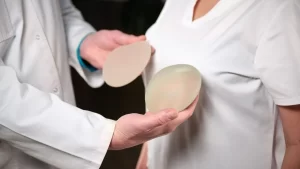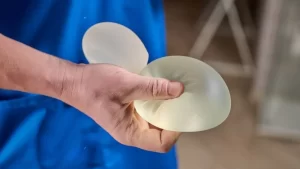Breast implants are one of the most common procedures in plastic surgery. However, correctly determining the ideal size of the implant plays a crucial role in the success of this procedure. Choosing the right size breast implant is of great importance to meet the patient’s aesthetic expectations and to minimize long-term health risks. An improperly sized implant not only negatively affects the aesthetic results, but can also reduce the patient’s quality of daily life. Therefore, determining the appropriate implant size for each patient’s unique anatomical features is a vital requirement.
Criteria to consider when choosing a breast implant size

The selection of breast implant size is a carefully planned process based on the patient’s body structure and expectations. The main goal is to achieve a natural appearance that suits the patient’s anatomical features and aesthetic expectations. Factors such as skin elasticity and the amount of existing breast tissue are also important parts of this evaluation process. When all of these elements are brought together, the ideal implant size for the patient can be determined. Although many women want to have larger breasts, acting without considering the issues that may arise after the procedure carries health risks. For this reason, breast implant selection should be done by taking into account not only aesthetic expectations, but also the patient’s health and quality of life. At this stage, the criteria to be considered are as follows:
Anatomical assessment
 A detailed examination of the patient’s anatomy is required to determine the ideal size of the implant. Basic parameters such as rib cage width, shoulder structure, height, and weight must be considered. For example, placing very large implants in someone with a narrow rib cage may result in an unnatural aesthetic appearance and may lead to health issues. However, the dimensions of the area where the implants will be placed must also be evaluated; this determines the risk of the implants moving over time or whether they will settle naturally. At this stage, the knowledge and experience of a professional surgeon is very important.
A detailed examination of the patient’s anatomy is required to determine the ideal size of the implant. Basic parameters such as rib cage width, shoulder structure, height, and weight must be considered. For example, placing very large implants in someone with a narrow rib cage may result in an unnatural aesthetic appearance and may lead to health issues. However, the dimensions of the area where the implants will be placed must also be evaluated; this determines the risk of the implants moving over time or whether they will settle naturally. At this stage, the knowledge and experience of a professional surgeon is very important.
Mammography and Ultrasound
It is also important to evaluate the breast with mammography and ultrasound imaging. These tests help determine the thickness of breast tissue and possible abnormalities such as cysts or tumors. With a mammogram, not only can breast tissue be seen, but also the position of implants, helping to detect potential issues earlier in the future.
Age and birth control pills
Age is another important factor for breast implants. Young women may have breast tissue that has not yet fully developed. Therefore, age appropriateness must be assessed before breast implants are recommended. Birth control pills should also be considered, as these medications can affect the growth of breast tissue by altering hormone levels.
Patient expectations
 A patient’s personal expectations are one of the most important factors in determining implant size. While most patients usually request a specific size, such as a C or D, they may not know exactly how these measurements will look in reality. At this point, it is important for the surgeon to guide the patient by visualizing the possible outcomes. The patient’s lifestyle, occupation, and daily activities should also be considered. For example, a patient who is actively involved in sports may prefer a different size or type of implant. Therefore, open, transparent and mutual communication between doctor and patient must be ensured.
A patient’s personal expectations are one of the most important factors in determining implant size. While most patients usually request a specific size, such as a C or D, they may not know exactly how these measurements will look in reality. At this point, it is important for the surgeon to guide the patient by visualizing the possible outcomes. The patient’s lifestyle, occupation, and daily activities should also be considered. For example, a patient who is actively involved in sports may prefer a different size or type of implant. Therefore, open, transparent and mutual communication between doctor and patient must be ensured.
Breast Implant Types and Selection
Choosing the type of implant is as important as choosing the size. Implants, usually made of silicone, are available in round or drooping (anatomical) shapes. Round implants give the upper breast area a fuller appearance, while drooping implants provide a more natural, aesthetically pleasing appearance. In addition, the quality of the implant material is also a deciding factor in terms of long-term satisfaction. High-quality silicone implants offer a more natural feel and durability. Therefore, the types of implants and the characteristics of the implant material should be discussed in detail with the patient. The patient should take into account the doctor’s advice in choosing the implant that is most suitable for his/her body and will give the desired results.
Choosing the size of the implant
Implant size is also very important in breast augmentation surgery. One of the most common questions asked by the doctor performing breast augmentation surgery is which implant size the patient should choose. There is no single answer to this question, as each patient’s body structure and desires are different. However, in general, the best option is to choose an implant that is proportional to the patient’s body.
asked by the doctor performing breast augmentation surgery is which implant size the patient should choose. There is no single answer to this question, as each patient’s body structure and desires are different. However, in general, the best option is to choose an implant that is proportional to the patient’s body.
As a result of the examination, your doctor will examine your body structure and the shape of your breasts and suggest the most appropriate implant size. It is important to note that the size of the implant will not only affect the size of the breast but also the skin tissue. For example, an implant that is too large can cause distortions in the skin and ultimately prevent a natural appearance.
In addition to the patient’s wishes, body structure is also an important factor in the size of the implant. For example, in the case of a thin and tall patient, large implants may result in an unbalanced and artificial appearance. For this reason, your doctor will recommend the right size for you, which will ensure an aesthetically pleasing result and will not jeopardize your health.
You should also keep in mind that breast shape also plays an important role in implant selection. If you like large, full breasts, round implants may be more suitable for you. If you want a more natural look, you can opt for drop-shaped implants.
Another point to consider is the quality and durability of the implant. A high-quality implant will provide results that will satisfy you in the long run. For this reason, you can ask your doctor to recommend the best quality product when choosing an implant.
Implant placement techniques also play a major role in choosing the size and type. Choosing to place the implant sub-muscularly or supramuscularly directly affects the look and feel of the implant. For example, submuscular placement often provides a more natural appearance and reduces the risk of complications. Supramuscular placement may be more appropriate for individuals who play sports. These techniques should be customized to the patient’s individual needs and performed by an experienced surgeon.
Long-term effects of breast implants
 Breast implants are generally long-lasting, but each implant has a specific lifespan. In most cases, a revision surgery may be needed after 10 to 15 years. Choosing the correct size, type, and placement technique can prolong this period and minimize the risk of complications. The need for revision may arise due to implant displacement, capsular contracture, or aesthetic dissatisfaction. Such issues can be avoided with proper planning and surgeon selection prior to surgery.
Breast implants are generally long-lasting, but each implant has a specific lifespan. In most cases, a revision surgery may be needed after 10 to 15 years. Choosing the correct size, type, and placement technique can prolong this period and minimize the risk of complications. The need for revision may arise due to implant displacement, capsular contracture, or aesthetic dissatisfaction. Such issues can be avoided with proper planning and surgeon selection prior to surgery.
Breastfeeding and breast implants
The question of whether breast implants will affect breastfeeding function is among the most frequently asked questions by patients. Surgery planned with the right techniques usually does not adversely affect the ability to breastfeed. Since the implants are placed in an area away from the milk ducts and breast tissue, there is no issue during breastfeeding. However, the experience of the surgeon and the placement technique used are the determining factors in this regard. It is very important to discuss these matters in detail before the procedure. In addition, due to the possibility of changes in breast size after childbirth, the size of the implants should be planned well in advance.
During breastfeeding, excessive stretching and sagging of the breast may occur during breastfeeding. Therefore, aesthetic issues may occur after breastfeeding. However, these issues are usually due to the structure of the breast tissue and there is nothing that can be done about it. Therefore, the skill and experience of the surgeon is very important when using silicone breast implants.
after breastfeeding. However, these issues are usually due to the structure of the breast tissue and there is nothing that can be done about it. Therefore, the skill and experience of the surgeon is very important when using silicone breast implants.
The recovery process after surgery may vary for each woman. However, it is usually possible to return to normal activities within 2-3 weeks. Full recovery can range from 6 months to 1 year after surgery.
For moms who want to continue breastfeeding, silicone implants can be used without harming milk production. However, you should discuss this issue in detail with your doctor and take care of the necessary precautions.
Schedule an appointment with Dr. Fatih Dagdelen
Choosing a breast implant size is a completely personalized process and should be done under the supervision of an experienced plastic surgeon. At Durrat Hospital in Fulya, Istanbul, we are ready to offer you the most suitable solutions with our experienced team in plastic and cosmetic surgery. By contacting us, you can determine the size and type of implant that best suits your body structure and expectations, and achieve your dream results.
You can visit our website or contact us via WhatsApp to schedule an appointment and get detailed information. Remember, “Get it once, get it all!” It is possible to achieve your beauty goals with the right choices and expert guidance.
